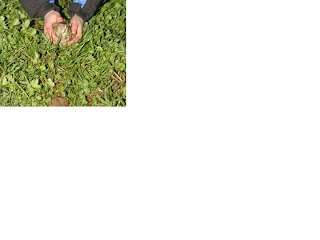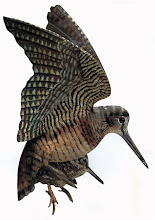Here the accuracy of LC 2 and LC 1 locations given by Argos:
- Class 2: better than 350 m, 500 m radius
- Class 1: better than 1000 m, 1500 m radius
Taking as good the LC 2 and LC 1
[7] locations given by our bird (Navarre), we have calculated the discrepancy of LC B locations and LC A locations from the good ones (LC 2 and LC 1) in the following way:
Assuming as on March 5th that we have a LC 2 location followed by a LC B location, in a very short period of time when the bird is supposed not to move, the accuracy of LC B location is, more or less:
0.500 km + distance between LC 2 and LC B (measured through Google Earth): 0.500 + 0.6 = 1.100 km
Studying all the data given by our birds, we have found that in the worst cases taking into account locations in very short periods of time, where it is supposed that the bird doesn't move:
(1) The accuracy of the LC A and LC B locations depend on the pair PTT/bird.
(2) For
Navarre, ID 73388, the LC A locations, in the studied cases, have an error between 5.46 and 9.37 km
[8].
(3) For Navarre, ID 73388, the LC B locations, in the studies cases, have an error between 1.10 and 10.82 Km.
We have very few samples of data from the Asturian bird to compare LC A and LC B locations; even worse, we do not have any emission with LC 2 or LC 1 location to measure the discrepancies. We can only say the following:
(4) For the Asturian woodcock, ID 72452, the distance between LC A locations, in very short periods of time, has an error between 0.42 and 3.66 km.
(5) For the Asturian woodcock, ID 72452, the distance between LC B locations, in very short periods of time, has an error between 3.12 and 4.36 Km.
In this case, we needed at least a LC 3, a LC 2 or a LC 1 location to measure the error of these locations.
All in all, one can say that, whatever the real errors of LC A locations and LC B locations for this bird, the LC A locations do not have a big difference among their errors (0.42-3.66), neither LC B locations among theirs (3.12-4.36).
(6) Using the same methodology, our LC 0 locations for Navarre can be considered as pretty goods. For Navarre, ID 73388, the LC 0 locations, in the studied cases, have an error between 5.18 and 5.90 km.
(7) In our experiment one LC B location has more accuracy than LC 1 locations and two LC A locations had equal accuracy than LC 0 locations, in line with the works of Hays et al. and Vincent et al.
[9].
Now, let’s see the data in 2008:
(8) In 2008 Navarre, ID 73388, has given very few good positions to make such kind of calculus.
We have only a datum, on May 16th, when we have a LC 2 location (at 3:27 UTC) followed by an LC A location (at 3:22). Five minutes between both locations.
If we apply the above mentioned methodology (as an exercise, since, the time between both locations is too long):
Distance (through Google Earth) between LC 2 and LC A locations: 4.5 km.
Accuracy of LC 2 location according to Argos: 500 meters.
So, in the worst of all cases, accuracy of that LC A location: 4.5 + 0.50 = 5.00 km.
But, five minutes is too long. So, let’s try a new methodology.
New methodology
Velocity of fly
[10]:
When Araba was flying at night, above the sea, we calculated his velocity: 66km/h, in tune with the literature.
Assuming a velocity of 60 km/h during the day, high enough, we can perform the following calculus.
1m/s = 3.6 Km/h, so 60 km/h = 16 m/s, but let’s take this very extreme hypothesis as good.
(9) Let’s use this new methodology with Navarre:
As mentioned above, in the worst of all cases, accuracy of Navarre’s LC A location, on May 16th: 4.5 + 0.50 = 5.00 km.
Now we have to add the possible space traveled in those five (5) minutes (a very strong hypothesis).
5 x 60 x 16 ---> 4,800 meters ---> 4.8 km.
So the accuracy of the LC A location given by Navarre is 4.8 + 5.00 = 9.85 km.
(Again, the hypothesis is really strong.)
(10) With Laguna (ID 83297) and Araba (ID 83300) we don’t have the possibility to know the accuracy of LC A and LC B locations, since the locations given in a single emission are not very near in time.
Assuming, as on March 16th, that we have, for
Araba (ID 83300), a LC 1
[11] location followed by a LC A location, in a period of time of 4.5 minutes, the accuracy of LC A location is, more or less:
Accuracy of LC 1 location (according to Kaatz) 3.19 km + distance between LC 1 and LC A locations (measured through Google Earth) + distance traveled by the bird (at 16 m/s) in those 4,5 minutes:
3.19 + 0.5 + 4.32 = 8.01 km.
We don’t have any more data to apply this new methodology.
Upshot
The point to be underlined is that in order to track the Eurasian woodcocks these LC B and LC A locations are very important: furthermore, they are real, objective and with a little work one can get their accuracy.
Bibliography
Hays, G. C., S. Åkesson, B. J. Godley, P. Luschi and P. Santidrian (2001)
Kaatz, M. (2004) Mit Prinzesschen unterwegs, 25 Jahre Storchenhof Loburg, 25 Jahre NABU-Bundesarbeitsgruppe Weißstorchschutz. Thesis’ title: Der Zug des Weißstorchs Ciconia ciconia auf der europäischen Ostroute über den Nahen Osten nach Afrika.
Vincent, C., B. J. McConnel, M. A. Fedak and V. Ridoux (2002) Assessment of Argos location accuracy from satellite tags deployed on captive grey seals, Marine Mammal Science 18:301–322 (see
For more information, see http://es.scribd.com/doc/58456473/Accuracy-of-A-and-B-class-locations.












.JPG)








.bmp)
.bmp)
.bmp)
+19,000+km.bmp)
